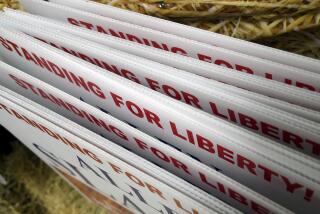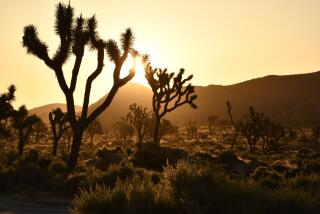Silence of a Winter Wonderland : Lifestyle: Although the quiet of his snowbound Wyoming cabin could be oppressive, one man cherishes the years he and his wife spent there.
- Share via
For several years, I lived with my wife in a log home in Wyoming, at an elevation of 7,000 feet, some 20 miles south of Yellowstone National Park and 37 miles from the nearest town. Each winter more than 40 feet of powdery snow fell onto this severe and yet ethereal world, and--measured by the length of time snow remained on the ground--each winter would last six or seven months.
We shared this frigid kingdom with a few year-round neighbors and a mostly friendly collection of moose, elk and coyotes. And occasional grizzly bears awakened from hibernation for a mid-winter snack.
There was scant human-caused pollution, so the non-blizzard days were breathtakingly blue. The nights, when illuminated by the moon, glowed with a ghostly light against the unsullied snow.
There were days when the temperature did not reach up to 20 degrees below zero, but no matter: We used Douglas fir and lodgepole pine to heat the cabin’s interior to 80 degrees so we could comfortably wear summer clothing. And although we were linked to the local power cooperative, we did not rely on electricity; we could live without it indefinitely and had to often because power outages were nearly as common as the blizzards that frequently snowed us in completely.
Life in that cabin was slow, filled with pleasant scents, regulated by the weather, and it seemed timeless and silent. Maybe it was the extreme quiet above all else that lent an aura of surrealism to it.
It seemed at times that the cabin, and the two human beings and one dog within it, had somehow been wholly separated from the rest of the world. We knew that the rest of the country was brimming with people and cars, work places and schools, shopping malls and parking lots, fast-food restaurants and museums, but none of that seemed connected to us any longer.
It was an eerie way to live in spite of its profound peace and prettiness. Silent. Silence everywhere around us like a strange new ocean, and then a lone coyote would howl in the distance. And then the immense silence again. Immediately. Minutes and hours of it.
I worked on my projects; my wife worked on hers. Our days were filled. In the evenings we cooked elaborate meals, listened to long symphonies on the stereo, read and read and read. Day after day, clear or snowy. We shoveled snow endlessly. Fed wood into the stoves. Listened to the quiet. Waited.
Cabin fever. It howls like a monstrous coyote within your mind. It makes you daydream of beaches in Mexico, forces you to perceive the chest-deep layers of snow outside your door as a specially made white prison, teases you to stay in your quilted bed in the morning and perhaps into the afternoon.
You want to see a gridlocked freeway in Los Angeles, a 50-story skyscraper in Manhattan, a field of corn in Iowa, suburbs of tract homes in Dallas. But no. You see only snow and yourself, and you hear only the icy silence and yourself. You are alone, even with your spouse sitting next to you at the table.
Now I live in a metropolitan area filled with people, cars, pollution, noise. A garish place. Life is wildly different. I never hear silence anymore, not real silence.
But occasionally, usually during early mornings, I slip back into my memories to recall those frozen years in Wyoming. And I realize that I appreciate them now more than ever. And I think to myself: There are people living like that right now. In all parts of the world. In snowy lands and in jungles and in deserts. In the old ways.
Bless them. Bless them in their silences, in their heart-beating dreams, in their snowy splendors, in their wood-smoke afternoons and in their long, long books.
More to Read
Sign up for Essential California
The most important California stories and recommendations in your inbox every morning.
You may occasionally receive promotional content from the Los Angeles Times.










